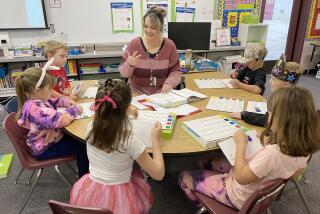Letter to Voices : Consequences of ‘Hands-on Learning’
- Share via
The article “Is Hands-On Learning Sending the Wrong Message?” by Arpi Sarafian (Voices, Dec. 19) expresses so well what is happening in the elementary schools of California today. Sarafian is right in her observations that the playground has been moved into the classroom and that many teachers are feeling angry and impatient that they are trapped in a system they cannot change.
I am one of those teachers. I have taught for more than 30 years in kindergarten through 8th grade, currently 5th grade. I care deeply about the children I teach, and I am very concerned about the radical changes I am observing in their response to learning. Today’s children are slipping into a pit of mediocrity. One might easily blame this on the ills of society, declining values, broken homes, and so on. This may be partly true. However, it is also true that the current teaching methods we are expected to implement are giving them a strong push into that level of poor performance. A handful of children excel with these new programs, but there are children who learn no matter what method is utilized. To Sarafian’s comments, I would like to add the following:
1. “Hands-on” science activities are wonderful motivators for interest in science. I utilize the technique regularly. However, they must be accompanied by some “old-fashioned” textbook learning and individual assignments that teach some specific scientific facts, rather than generalities of science.
2. Another technique in common use is “Cooperative Learning Groups.” On paper this technique has a noble purpose--to teach children to solve problems in a spirit of cooperation, with learning as the end product. But children are losing the ability to work alone. On individual assignments, they seek an easy answer by talking to their classmates rather than looking on their own. Also, when they work in these groups, some children never contribute.
3. If learning is not presented in a fun, entertaining manner, some children will not do the accompanying work at all. Every classroom today has its share of “non-workers,” who sit and do little or no written work at all.
4. All of these activities require a tremendous amount of preparation. Today’s teacher spends too much time on creating learning activities, often with no text or manual to follow. The hours are long and the stress levels are high. Today we are dealing with children who, for a variety of reasons, need more structure and higher expectations for their behavior and academic performance. Instead we are providing them with less structure and lowered expectations. The state board of education, administrators and legislators must become sensitive to the opinions of teachers and parents. Ask us! We know, for we see it every day.
PHYLLIS A. FICK
Elementary teacher, East Whittier
More to Read
Sign up for Essential California
The most important California stories and recommendations in your inbox every morning.
You may occasionally receive promotional content from the Los Angeles Times.













